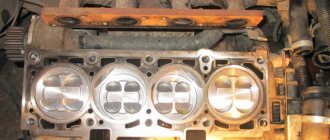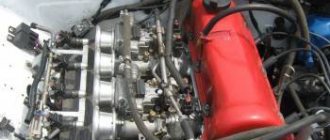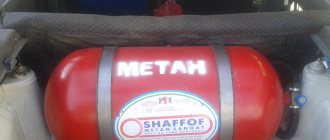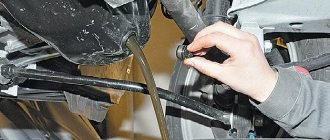AvtoVAZ is developing its 16-valve engines gradually, that is, step by step. When the updated Kalina family appeared in 2013, buyers were perplexed as to why they offered a 106-horsepower engine in manual versions, which differed little in design from the usual Priora engine.
The new engine was equipped with resonant supercharging, and it seemed that its presence would only have disadvantages: reliability was reduced, there was no way to connect the cable drive. But it turned out that the new engine was no worse than its predecessor: the mass air flow sensor often breaks down, and the DBP and DTV sensors almost never. There is no MAF sensor in the design of the 27th engine, which is the secret of increased reliability.
By the way, Lada Vesta with a Nissan engine is getting ready for release!
Engine hr16de-h4m
The HR16DE-H4M is a powerplant jointly produced by Nissan and Renault.
AvtoVAZ received permission to produce this power unit in Russia in 2022. The engine not only has a number of advantages over the previous ones, but also has disadvantages. The main advantage of the HR16DE-H4M is its undemandingness regarding the type of fuel. The car will drive great both on the AI-95 and on the cheaper AI-92. The manufacturer also did not dare to install an unreliable belt and decided to install a strong chain.
The main disadvantage is the lack of hydraulic compensators. This is inconvenient, because every 100 thousand kilometers you will have to adjust the gaps. The HR16DE-H4M is not equipped with AMT - only a CVT and manual transmission.
It was also noticed that foreign-made engine mounts for LADA Vesta wear out quickly, which causes knocking and noise.
Model 21127/21129
The first production samples of the Lada-Vesta car have an engine of this particular modification. The engine, compared to its predecessors, has become more economical, more productive, and received a new suspension and exhaust system.
Options:
- working volume – 1596 cubic centimeters;
- power – 106 “horses”;
- torque – 4,000 N;
- four cylinders - in-line;
- compliance with the Euro-4 environmental class with a compression ratio of 11.
The motor in question is also mounted on Priora, Granta and the updated Kalina. It has a belt drive, the ability to boost allows you to achieve a power of about one hundred and fifty horsepower, and with a compressor and turbine - another 2.5 times more.
Engine in Lada Vesta
LADA Vesta is a long-awaited Russian-made passenger car that belongs to class B. The production of this model in various trim levels began back in 2022 and since then it has held its position in the top best-selling cars on the domestic market.
Big changes in the new model, first of all, affected what is under the hood of the car - the engine. In this article you can thoroughly familiarize yourself with the technical characteristics of LADA Vesta engines.
Selecting engine oil for the 1.6 Lada Vesta SV Cross engine
This question is the most burning topic among car owners. The forums are literally exploding with the number of messages, the approximate essence of which boils down to one thing: “Take this, but don’t take this, because I took the wrong coat.” Therefore, I will not recommend a specific brand of motor oil. Let’s consider only the recommendations from the Lada Vesta Cross operating instructions.
AvtoVAZ recommends filling the 1.6 Lada Vesta Cross engine with motor oils with SAE viscosity:
5W-30 5W-40 10W-40 15W-40
5W-30 and 5W-40 oils are well suited for use in cold regions, while 10W-40 and 15W-40 are only suitable for use in warmer months or hot climates.
If the car is new, then it is also permissible to use oil with a viscosity of 0W-40. Especially if such a car is operated in a cold climate. This option will ensure good fluidity of the oil and its rapid flow to the rubbing parts.
There is also a second parameter by which you need to choose engine oil. This is a quality class. It can specify by API or ILSAC. In our case, it is recommended to use API SM and ILSAC GF-4 or higher oils. Anything that is of a lower class will not suit us.
Engine VAZ 21129
Before us is a modification of the VAZ 21127 engine and it was installed on the first LADA Vesta cars. Among the main distinctive features of this unit are the following:
- low fuel consumption;
- suspension improvements;
- low level of noise, knocking and toxicity;
- modified gas exhaust and intake system.
VAZ 21129 has not yet entered service, but the previous model, 21127, has proven itself to be very good. If desired, the car owner can easily increase the power to 150 horsepower.
For this engine, the manufacturer installed two gearboxes at once - manual and AMT (robotic gearbox). Fuel consumption on both boxes is the same - 10 liters within the city and 6 liters on the highway.
Powertrain from Nissan
Nissan developed the hr16 engine especially for the Lada Vesta. Such power devices cost a lot. Therefore, previously they were installed in vehicles produced by the concern.
Among the advantages of such a motor are:
- Reliability level has been increased. After all, Vesta engines are installed with additional elements. It is suitable for operation on various types of fuel (gasoline, methane gas). Therefore, each driver chooses which fuel to use. With fuel prices continually rising, this is good news for many drivers.
- Together with timing belts installed in harmony with the weight, manufacturers have introduced a chain system.
- Its operation helps reduce the cost of purchasing consumables. Chains are more durable, so they are replaced less frequently.
What kind of gasoline should I fill according to the recommendations?
The regular Vesta and the SW modification with the listed types of internal combustion engines can be operated on AI-92 and 95 gasoline. At the same time, fuel with a lower octane number (AI-92) can be poured in case of urgent need.
In practice, many drivers refueled their cars with 98-octane gasoline. After using this brand of fuel, no negative changes in the operation of the internal combustion engine were noticed.
However, higher octane slightly improved driving dynamics and reduced consumption. The 16 and 18 year old engines are more suitable for domestic fuel.
Engine 21179
AvtoVAZ was the first to introduce variable valve timing and use selective assembly on a conveyor belt. The 1.8-liter engine (122 hp) is not very different in appearance from the current VAZ sixteen-valve engines.
Updated engine parameters 21179:
- Throttle valve without mechanical drive.
- The cylinder head has additional oil channels for the phase regulator and lightweight Mahle valves.
- The catcollector is supplied by Russian, the diameter of the input channels is increased to 39 mm, the oxygen sensor bears the Bosch emblem.
- Crankshaft with increased crank radius.
- The working volume of the cylinders has “increased” due to the larger piston stroke.
- A reliable high-performance water pump is purchased from the Korean company GMB.
- For the first time, a VAZ has installed an imported GMB oil pump with increased performance.
- A new automatic timing belt tensioner with two rollers from the German company INA was used.
- Lightweight connecting rod and piston group manufactured by Federal Mogul.
- The fuel rail, injectors with increased productivity, and the spray pattern are optimized for the workflow of the new engine.
Specifications
Making the right choice when buying a car will be much easier with a deeper knowledge of the characteristics of this engine.
Features of the power unit 21179:
| Engine capacity, cc | 1774 |
| Maximum power, hp | 122 — 145 |
| Maximum torque, N*m (kg*m) at rpm. | 170 (17) / 3700 187 (19) / 3600 |
| Fuel used | Gasoline AI-92 Gasoline AI-95 |
| Fuel consumption, l/100 km | 6.8 — 7.9 |
| engine's type | In-line, 4-cylinder |
| Add. engine information | Electronic fuel injection |
| Number of valves per cylinder | 4 |
| Maximum power, hp (kW) at rpm | 122 (90) / 5900 122 (90) / 6050 145 (107) / 6200 |
| Supercharger | No |
Advantages and disadvantages
Even the leaders of the global automobile industry do not have ideal cars. Potential buyers will be interested in what the main advantages and disadvantages of this car are compared to old AvtoVAZ models and other cars presented in this price category. It is the ratio of pros and cons, expressed by differences in technical characteristics and convenience parameters, that primarily influences the consumer’s choice.
Positive features of the engine:
- Oil pump with increased power.
- Imported camshafts are lightweight.
- The cylinder head received additional oil channels that deliver fluid to the new phase shifter.
- The cooling system has been improved, an imported water pump of greater power with high reliability indicators has been used.
- The systems are controlled similarly to the VAZ 21127 model through DBP and DTV, and not through the previously familiar mass air flow sensor, which also has a positive effect on the reliability and stability of operation.
- The domestically produced intake tract was made specifically for the characteristics of the new power unit.
- The new engine is adapted for the use of cheaper fuel with an octane rating of AI-92.
- Maximum power - 122 hp. s., torque - 172 N/m. The engine received a flat torque plateau, which allows it to achieve a torque of 127 N/m at 1000 rpm, which is 7 N/m higher than the maximum performance of the base VAZ 11183 engine.
Despite the positive aspects, the engine of this car has its disadvantages.
Engine disadvantages:
- The engine is a modification of the 16-valve Priora engine. For some, it rattles when not warmed up or at idle, and often whistles. Such a whistling sound is generally characteristic of such a motor, so you can simply ignore it.
- The weak link of such engines remains the electrics: some complain about the gas pedal, starts on the 2-3rd attempts, even when it’s warm, and unstable idle. A Vesta with a Euro-5 engine only needs high-quality gasoline; bad fuel can cause hang-ups and bent valves.
- The new 1.8 engine for Vesta may surprise you with increased oil consumption at the start of driving. There was a theory that the cause could have been poorly processed Chinese valve stems, which AvtoVAZ quickly replaced with others, thus eliminating the problem.
What kind of engine is installed on the Lada Vesta?
The main engines for the Lada Vesta, which are installed by the manufacturer, are already indicated in the introduction. The company's decision to refuse to install the VAZ-11189 engine in the basic configuration was a winner. It seriously idles even on Grant and Priora; in fact, it is a modification of the VAZ-11186 model known to many.
The only difference is that it has different intake and exhaust valves. The decision is due to the heavier body of the new car and increased requirements for the driving characteristics of the installed engine. There are three types of installations with different characteristics installed on cars. Two with a volume of 1.6 liters. and one 1.8 l. At 21179 AvtoVAZ had to increase engine power by 14 horses, without increasing appetite.
While writing this review, they traveled thousands of kilometers and we are ready to talk about the results. Recently, a wave of discussions was caused by the fact that one of the engines was not developed by VAZ, but will be supplied by Japanese manufacturers. Moreover, instead of the usual timing belt, it has a chain and it has more power. This allows you to seriously increase the power output of the motor. Is a chain better than a good engine belt?
Vesta 21129 engine tuning
Aspirated
As mentioned above, Vesta motor uses the new M86 controller and today there are some problems with its firmware. You can do a regular chip tuning, buy a 4-2-1 exhaust manifold, a 51 mm exhaust system. This will increase the power slightly (5-8 hp) and improve the sound. In a good way, there is no need to climb further, the car is quite heavy and you won’t get any crazy dynamics anyway; a lightweight Priora or 2114 with a similar tuning will be ahead.
ENGINE RATING: 3+
<<BACK
Motor VAZ 21129
Let's talk about the first of two Russian models. There are quite a few differences between the 129 engine and the 127 Priorovsky, the youngest in the model range. In comparison with the VAZ-11186 engine, with a volume of 1.6 liters, it has a power of 106 horsepower. This difference is due to 16 valves instead of 8 in the previous version. Ambient temperature sensors and absolute pressure sensors are installed as standard. Characteristics of this Lada Vesta engine.
Power - 106 horsepower, spins up to 5800 rpm. Volume - 1.6 l. A highly modernized engine mount has been installed. Drive and timing type: standard DOHC timing belt. Torque characteristics - 1484200. Motor weight - 109.2 kg. Cast iron cylinder block Electronic ignition system controlled by a processor.
Adds dynamics to the car. Fuel type is unleaded gasoline with an octane rating of 95, but 92 is also possible. Power supply is via a distributed injection system. The car will accelerate to 100 km/h from 21129 in 12.8 seconds. With a 129 engine, Vesta consumes gasoline: in the city - 10.2 liters, mixed driving - 7.5 liters, on the highway - 6.2 liters.
New Lada: Ways to solve the problem of the Grants generator - »
Toxicity is at a level characteristic of the Euro 5 standard.
The running life is set at 200 thousand km.
Innovations compared to the design of the previous model monitor the quality of fuel, and do not idle. The damper system regulates the air supply at different speeds, which gives traction to the engine from the bottom and at the top.
Changes in the design of the 129 motor, facilitating long-term operation:
— a cylinder block with increased rigidity is installed, and other engine systems are improved. Compared to previous models, it shows an increase in quality indicators and meets European quality standards;
— the piston has one oil scraper ring and two thin compression rings, which reduces loss of performance due to friction;
— extensive opportunities for improving the power unit, tuning increases power to 145-150 hp.
The only noticeable drawbacks of the 129 engine are the high, uneven tone noise level. It may appear after prolonged use and at the very beginning. When the timing belt breaks, like most VAZ engines, it suffers from the fact that the valves bend.
Description
The new engine received the VAZ-21129 index. However, it would be a stretch to call it new. In fact, this is the same VAZ-21127. The main changes concerned improvements leading to compliance with Euro 5 toxicity standards. At the same time, minor changes affected the mechanical part of the engine.
The VAZ-21129 engine is an in-line four-cylinder 16-valve naturally aspirated engine with a volume of 1.6 liters and a power of 106 hp. s and a torque of 148 Nm.
Installed on Lada cars:
- Vesta (2015-present);
- X-Ray (2016-present);
- Largus (2017-present).
The cylinder block is cast from high-strength cast iron. The working surfaces of the liners are honed. The cooling cavities are made by casting, and the channels connecting them are made by drilling. Additionally, the design of the supports and the oil pan has been changed. Overall, the cylinder block has become more rigid.
The cylinder head traditionally remained aluminum, with two camshafts and 16 valves (DOHC). There is no need to manually adjust the thermal gap, since the pushers are hydraulic compensators.
The pistons are also made of aluminum alloy. They have three rings, two of which are compression and one is oil scraper. There are recesses in the piston crown, but they do not protect the valves in the event of contact (for example, in the event of a broken timing belt). In any case, when encountering a piston, bending of the valves, as well as destruction of the piston, are inevitable.
The result of the meeting of the piston with the valves
The changes affected the piston skirt. Now it has become short (lightweight) with graphite coating. The rings also received an improvement - they became thinner. As a result, the friction force of the ring-wall pair of the cylinder liner is reduced.
The connecting rods are “chipped”, with a steel-bronze bushing pressed into the upper head.
The crankshaft has been slightly modified. Now there are special additional drillings in its body, thanks to which oil starvation of the connecting rod journals is eliminated.
The intake system has received changes. The VAZ-21129 is equipped with an intake receiver with variable geometry and chamber volume. This is achieved by introducing a system of dampers that regulate the length of the intake manifold.
Oil nozzles appeared in the lubrication system, cooling the piston heads.
The mass air flow sensor is excluded from the electrical system. Instead, atmospheric pressure and air temperature sensors are installed.
As a result of the modification, the idle speed has stabilized and the technical and economic indicators of the engine have increased.
Additionally, in the electrical part, the ECU of the old engine was replaced with a new one (M86). The operation of all electrics is carried out from the energy generated by a modernized DC generator.
Dependence of power on torque of the VAZ-21129 in comparison with the 1.8 liter VAZ-21179
The unit is adapted for use with different types of transmissions (manual transmission and automatic transmission-AMT).
Which engine should you choose when buying a Lada vesta?
Lada Vesta is equipped with three types of engines with different technical characteristics, two of which have a volume of 1.6 liters, and the third has a volume of 1.8 liters. Models 21129 and 21179 were designed and assembled directly by AvtoVAZ, and the Nissan HR16 DE engine was created by foreign partners.
Each of the new units has its own positive and negative sides. The installation of an engine from a Japanese manufacturer (Nissan) on the Lada Vesta with a chain instead of a timing belt and a number of other differences became a sensation of sorts. A description of the features of the new engines follows in the text.
ICE 21179
When determining which power engine is preferable for the Lada Vesta, the features of 21179 are taken into account. Previously, a unit with a volume of 1.8 liters was not used to equip the Lada Vesta. Manufacturers plan to equip the cross station wagon with this device.
This engine on the Lada Vesta is complemented by a five-speed automatic transmission. During preparation, a selective technique was used. This affected the distribution of gases, which is carried out in a specific way. That's why they complete the news.
What engines are installed in the Lada Vesta Lux? For this configuration, power unit 21179 is used. Why? To understand everything, study the technical characteristics:
- Volume – 1.8 liters.
- Performance – 122 horsepower.
- At maximum performance, the torque reaches 170.
- The engine life reaches 290–300 thousand km.
- The compression ratio is optimal.
Although the engine's performance is outstanding, there is a downside. When using this power unit, fuel costs increase. But due to the fact that a car with such an engine quickly picks up speed, not all drivers take fuel consumption into account.
The reliability level of the unit is quite high. Therefore, its popularity is gradually increasing.
Analysis of the characteristics of the VAZ 21129
This engine is installed on the Lada Vesta and works with both a manual transmission and a robot. Has the following technical characteristics:
| Power | 106 hp |
| Volume (l) | 1.6 |
| Drive and timing type | Toothed belt, DOHC |
| Torque (Nm) | 148/4200 |
| Weight | 109.2 kg |
| Ignition | Electronic system controlled by microprocessor |
| Fuel type | Unleaded gasoline, 95 |
| Nutrition | Distributed injection |
| Speed up to 100 kilometers per hour | Happens in 12.8 s |
| Fuel consumption city (l) | 10,2 |
| Combined fuel consumption (l) | 7,5 |
| Fuel consumption highway (l) | 6,2 |
| Toxicity | Euro 5 |
| Resource | 200,000 kilometers |
Future powertrains
Many car enthusiasts are interested in whether they plan to install a diesel unit on the Lada Vesta. There are no official data online. But some drivers note that a new engine is being developed. This engine will have new elements. But whether this is true has not yet been confirmed. And there is no description of the power unit.
When choosing a package, it is important to take into account the features of the motor that is being installed. After all, how efficient the unit will be and how long it will work without interruption depends on its technical characteristics and parameters. If necessary, additional indicators are taken into account. In order to understand whose option to use, many points are taken into account.
In this article we will talk about the 21129 motor, which replaced the Priorovsky 21126 motor, we will talk about its differences from its predecessor, and its problems. This motor is installed on Grants, Kalinas, Priors. Vesta will also receive this engine, and already from the first batch. The 129 engine is the same 127, but with different firmware to comply with Euro-5 toxicity standards, thereby making it possible to sell the Vest in Europe.
Lada Vesta engine life - you need to know
Life tests of the units installed on Vesta allow us to say that the overall impression of them is rather good.
New Lada: Buy new LADA (VAZ) Kalina in Moscow - a lot of new Lada Kalina on Avto.ru
We have already mentioned what resource the factory installs in the description of each motor; here we will briefly write:
— VAZ 21129 resource — 200,000 km; — motor life of the VAZ 21179 engine is 300,000 km; — resource hr16de from Nissan — 250,000 km.
Tuning is available in a wide variety of designs. Excellent options for tuning measures to improve driving characteristics would be the installation of a lightweight crankshaft and forward air flow. You can install an additional turbine; after modification, you need to improve not only the engine, but also other components of the car.
The main malfunctions and ways to eliminate them are:
1. An unpleasant whistle under the hood - most likely the timing belt has stretched and is close to breaking. It is better to replace if possible;
1.1 Unpleasant bubbling noise under the hood - the hr16de chain may have stretched and requires attention; 2. The engine stalls regularly for no apparent reason - a likely scenario is that the relay in the ignition unit has failed. It can be repaired during a recall campaign for defective vehicles; 3.
At medium speeds, a characteristic nasty sound occurs - the gasket in the exhaust pipe has burned out or is burning out. Replacement is easy, especially if you contact the ASC; 4. The appearance of such a phenomenon as vibration - in VAZ engines this is a design flaw associated with the right airbag. Replace and the problems will disappear.
5. Increased fuel consumption, unstable operation, sluggish acceleration from more than 15 to hundreds - the oxygen concentration sensor (lambda probe) may be broken.
Description of the HR16 DE motor
In the imported version, the power plant has a power of one hundred and seventeen horsepower. The engine is mounted on various vehicles, and since 2015 it has also been equipped at the VAZ plant. The engine is unpretentious in terms of fuel quality; instead of a timing belt, it is equipped with a chain drive.
In addition, the unit includes a modified gas distribution system, an electronic throttle valve, and a phase shifter. At the same time, there are no hydraulic compensators, which requires adjusting the gaps every 85-95 thousand kilometers. Otherwise, extraneous noise and knocking will appear.
Real indicators based on reviews from car owners
The standard 1.6-liter engine is paired with a 5-speed manual transmission and a robot. The quality of the transmission as a whole does not cause any complaints from owners. Also, drivers often wonder what kind of gasoline is best to fill in the Lada Vesta? The manufacturer recommends refueling only with 95-octane gasoline; this information can be found in the vehicle documentation. This is important to take into account, because the nominal resource was determined taking into account many indicators, in particular, taking into account the octane number of the fuel.
Peculiarities
The designers are planning other options for completing the power unit. The Lada Vesta car, the engine of which is equipped with a special groove for the gas valve, which allows it to be converted to a similar fuel, is easy to convert to a new engine. Considering the cost-effectiveness and price fluctuations in the oil market, this solution is very promising.
The fuel tank hatch is slightly enlarged. It is also designed for a dual-fuel system (gasoline plus methane). Imported power units, thanks to chain transmission, are more reliable. Therefore, they are recommended to be installed when switching to gas.
User reviews
As consumers note, the variety of power units installed on the Lada Vesta is a good solution that allows you to choose an option for everyone’s liking and needs. The motors of the 21127 and 21129 series, which are similar in many respects, have proven themselves to be quite good. The Nissan version, despite its high cost, is perfect for this car. Its main advantage is the presence of a chain drive rather than a belt drive in the gas distribution mechanism block.
Reviews of Lada Vesta engines confirm that the developers do not stop and continue to improve the heart of the domestic car. By providing the engine with timely preventive maintenance and proper operation, you will be able to use up the entire resource of the unit without experiencing any special problems.










